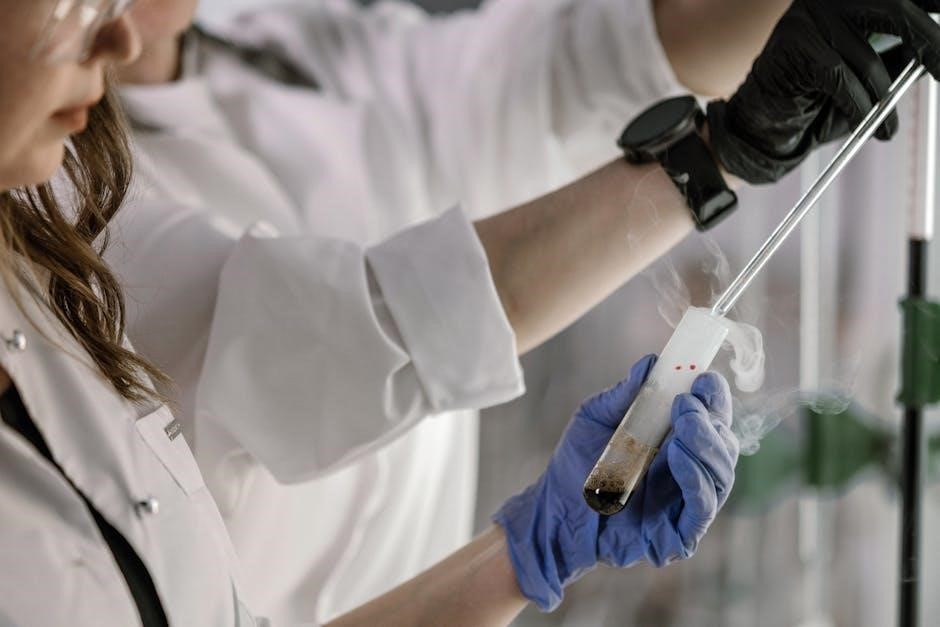The Organic Chem Lab Survival Manual: A Comprehensive Guide
The Organic Chem Lab Survival Manual by James W. Zubrick serves as an indispensable resource for students navigating the challenging world of organic chemistry laboratories. This manual emphasizes essential techniques, safety, and doing work correctly the first time, and it is used in sophomore and junior level courses.
The Organic Chem Lab Survival Manual, penned by James W. Zubrick, stands as a cornerstone for students embarking on their organic chemistry laboratory journey. This manual is more than just a collection of procedures; it is a comprehensive guide designed to equip students with the skills and knowledge necessary for success in the lab. Zubrick’s approach focuses on clarity, humor, and practicality, making complex techniques accessible to sophomore and junior-level students.
The manual emphasizes the importance of understanding the underlying principles behind each experiment, fostering a deeper comprehension of organic chemistry concepts. Furthermore, it stresses the significance of safety in the laboratory environment, providing detailed protocols and guidelines to minimize risks. By promoting a “do it right the first time” mentality, Zubrick encourages students to develop meticulous work habits and attention to detail.
This manual is more like advanced technique books by Wiberg, Lowenthal, Newman, and Gordon and Ford. This approach not only enhances their experimental skills but also cultivates a sense of confidence and competence in the lab.
Key Techniques Covered in the Manual
The Organic Chem Lab Survival Manual meticulously details essential techniques vital for success in the organic chemistry laboratory. These techniques form the foundation upon which students build their experimental skills and understanding of organic reactions. The manual provides step-by-step instructions, clear explanations, and illustrative diagrams to guide students through each procedure.
Distillation, a cornerstone of organic chemistry, is thoroughly covered, encompassing simple, fractional, and steam distillation methods. Extraction techniques, crucial for separating and purifying compounds, are explained in detail, including liquid-liquid extraction and solid-liquid extraction. Recrystallization, another essential purification method, is presented with emphasis on solvent selection and crystal growth.
Furthermore, the manual delves into spectroscopic techniques such as nuclear magnetic resonance (NMR) and infrared (IR) spectroscopy, empowering students to analyze and interpret data for compound identification. Chromatography, including thin-layer chromatography (TLC) and column chromatography, is also discussed, enabling students to separate and analyze mixtures effectively. By mastering these key techniques, students gain confidence and proficiency in the organic chemistry laboratory. The manual also touches on spot staking the pH of an organic layer.
Safety Protocols Emphasized by Zubrick
The Organic Chem Lab Survival Manual places paramount importance on safety protocols within the organic chemistry laboratory. James W. Zubrick emphasizes that a safe laboratory environment is not merely a suggestion, but a necessity for preventing accidents and ensuring the well-being of all individuals involved. The manual meticulously outlines a comprehensive set of safety guidelines that students must adhere to at all times.

Eye protection, specifically the consistent use of safety goggles, is rigorously stressed to shield against chemical splashes and potential projectiles. Proper handling of hazardous chemicals is thoroughly discussed, including the use of appropriate personal protective equipment (PPE) such as gloves and lab coats. The manual details procedures for the safe disposal of chemical waste, emphasizing the importance of segregation and proper labeling to prevent environmental contamination and accidental reactions.
Furthermore, Zubrick underscores the significance of understanding chemical hazards and Material Safety Data Sheets (MSDS). Emergency procedures, including spill response and fire safety, are comprehensively covered, equipping students with the knowledge and skills to react effectively in unforeseen circumstances. By instilling a strong safety culture, the manual empowers students to conduct experiments responsibly and minimize potential risks.
Essential Equipment and Its Usage
The Organic Chem Lab Survival Manual meticulously details the essential equipment found in an organic chemistry laboratory and provides comprehensive instructions on their proper usage. James W. Zubrick understands that familiarity with equipment is fundamental for successful experimentation. The manual guides students through the intricacies of glassware, heating devices, and various analytical instruments;
Detailed explanations are given for common glassware items like beakers, flasks, condensers, and distillation apparatuses, emphasizing proper handling and cleaning techniques. Heating mantles, hot plates, and Bunsen burners are discussed with clear guidelines on safe and controlled heating methods. The manual elucidates the principles and operation of essential instruments such as rotary evaporators, melting point apparatuses, and spectrophotometers.
Furthermore, Zubrick offers practical advice on setting up experimental apparatuses correctly, ensuring leak-proof connections and proper alignment. The importance of calibration and maintenance of instruments is also highlighted. By providing a thorough understanding of equipment and its usage, the manual empowers students to execute experiments accurately, efficiently, and safely, laying a solid foundation for their laboratory skills.
Troubleshooting Common Lab Issues
The Organic Chem Lab Survival Manual equips students with the knowledge to troubleshoot common issues encountered in the organic chemistry laboratory. James W. Zubrick anticipates potential problems and provides practical solutions, turning obstacles into learning opportunities; The manual addresses issues such as unexpected reaction outcomes, difficulties in product isolation, and malfunctioning equipment.
Detailed troubleshooting guides are included for common experimental techniques like distillation, extraction, and recrystallization. Zubrick provides insights into identifying the root causes of problems, such as impurities, side reactions, or procedural errors. He offers step-by-step instructions on how to rectify these issues, including adjustments to reaction conditions, purification methods, or equipment settings.
The manual also covers common equipment malfunctions, such as leaks in glassware, temperature control problems, and issues with vacuum systems. Zubrick offers practical advice on diagnosing and resolving these problems, often with simple solutions that can save time and prevent frustration. By providing a comprehensive troubleshooting guide, the manual empowers students to become resourceful problem-solvers in the laboratory.

Data Analysis and Interpretation
The Organic Chem Lab Survival Manual emphasizes the importance of data analysis and interpretation in organic chemistry experiments. James W. Zubrick guides students through the process of collecting, analyzing, and interpreting experimental data to draw meaningful conclusions. The manual underscores the need for accurate record-keeping and proper data representation, which are essential for scientific communication.
Detailed explanations are provided for common analytical techniques used in organic chemistry, such as spectroscopy (NMR, IR, UV-Vis) and chromatography (GC, TLC). Zubrick illustrates how to interpret spectra and chromatograms to identify compounds, determine purity, and monitor reaction progress. He provides examples of spectral data and guides students on how to extract relevant information, such as chemical shifts, coupling constants, and peak integrations.
The manual also covers statistical analysis methods for evaluating experimental data, including error analysis, standard deviation, and t-tests. Zubrick explains how to assess the reliability and validity of experimental results and how to determine if observed differences are statistically significant. By providing a solid foundation in data analysis and interpretation, the manual enables students to critically evaluate their experimental findings and make informed conclusions.
Emphasis on Doing Work Correctly the First Time
A core tenet of The Organic Chem Lab Survival Manual, authored by James W. Zubrick, is the emphasis on performing experiments correctly from the outset. This principle is woven throughout the manual, highlighting the importance of careful planning, meticulous execution, and a thorough understanding of the underlying chemical principles. Zubrick stresses that avoiding mistakes saves time, resources, and frustration in the long run.
The manual provides detailed instructions and explanations for each technique, with a focus on potential pitfalls and common errors. Zubrick encourages students to read and understand the procedures thoroughly before starting any experiment. He emphasizes the importance of using the correct equipment, following proper safety protocols, and paying attention to detail throughout the entire process.
By instilling a mindset of accuracy and precision, The Organic Chem Lab Survival Manual aims to cultivate good laboratory habits that will benefit students throughout their scientific careers. Zubrick’s approach not only improves experimental outcomes but also fosters a deeper understanding of the subject matter and a greater appreciation for the scientific method.
Editions and Availability of the Manual
The Organic Chem Lab Survival Manual, written by James W. Zubrick, has seen numerous editions, reflecting its enduring popularity and relevance in organic chemistry education. Each new edition incorporates updated techniques, safety protocols, and pedagogical approaches to meet the evolving needs of students and instructors. The manual is available in both print and digital formats, making it accessible to a wide range of learners.
Students can purchase copies of the manual from major booksellers, online retailers, and university bookstores. Digital versions are often available for download or purchase through platforms like Wiley, offering convenient access on various devices. Used copies of older editions may also be found, providing a more affordable option for students on a budget.
Availability may vary depending on the region and the specific edition. Checking with local bookstores and online retailers is recommended to find the most current and suitable version of The Organic Chem Lab Survival Manual for your organic chemistry laboratory course. The latest edition ensures access to the most up-to-date information and best practices in the field.
James W. Zubrick: The Author and His Approach
James W. Zubrick is the esteemed author of The Organic Chem Lab Survival Manual, a widely recognized and respected guide for students venturing into the organic chemistry laboratory. Zubrick’s approach to teaching organic chemistry lab techniques is characterized by clarity, humor, and a strong emphasis on safety. He aimed to demystify complex procedures and make them accessible to students with varying levels of experience.
Zubrick’s writing style is known for its engaging and approachable tone, which helps to alleviate the anxiety often associated with organic chemistry labs. He explains not only the “how” but also the “why” behind each technique, fostering a deeper understanding of the underlying principles. This approach empowers students to think critically and troubleshoot problems effectively.
His manual reflects a commitment to providing students with the essential knowledge and skills needed to succeed in the lab. By emphasizing doing work correctly the first time, Zubrick instilled a sense of responsibility and attention to detail. Through his work, Zubrick has significantly contributed to the education and preparation of countless organic chemistry students.
The Manual as a Guide for Sophomore/Junior Level Courses
The Organic Chem Lab Survival Manual is specifically designed to serve as a comprehensive guide for sophomore and junior-level organic chemistry courses. These courses typically represent a student’s initial immersion into the practical aspects of organic chemistry, requiring them to master fundamental laboratory techniques and safety protocols. Zubrick’s manual effectively bridges the gap between theoretical knowledge and hands-on experimentation.
The manual covers a wide range of essential topics tailored to the curriculum of these courses, including distillation, extraction, chromatography, and spectroscopy. By providing clear explanations and step-by-step instructions, the manual enables students to confidently perform experiments and analyze their results. Moreover, it reinforces the importance of meticulous technique and accurate data collection.

Furthermore, the manual’s emphasis on safety is particularly crucial for students new to the organic chemistry lab environment. It provides detailed guidance on handling chemicals, using equipment safely, and responding to emergencies. Consequently, it helps create a safer learning environment.
Relevance and Importance for Organic Chemistry Students

The Organic Chem Lab Survival Manual holds immense relevance and importance for organic chemistry students due to its comprehensive coverage of essential laboratory techniques and safety protocols. It is not merely a collection of procedures; it is a guide that instills best practices from the outset. By emphasizing accuracy and efficiency, the manual prepares students for more advanced work.
Organic chemistry is a field that demands precision and attention to detail, and Zubrick’s manual cultivates these qualities in students. It provides a solid foundation in experimental techniques, enabling students to confidently design and execute experiments, interpret data, and troubleshoot problems. This hands-on experience is invaluable for students pursuing careers in chemistry, medicine, or related fields.
Moreover, the manual’s focus on safety is paramount, given the inherent risks associated with organic chemistry laboratories. Students who master the safety protocols outlined in the manual are better equipped to protect themselves and their colleagues from accidents. This emphasis on safety fosters a culture of responsibility.
